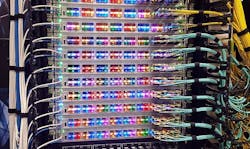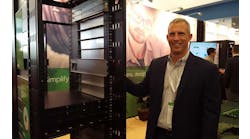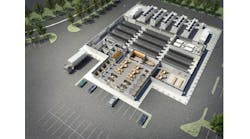The digital transformation of our economy is projected to generate an ocean of data, fed by a growing universe of intelligent things – sensors, cameras, smartphones, tablets, drones, robots and connected cars.
In a new report this week, Cisco predicts that machine-to-machine (M2M) applications will account for 51 percent of the total devices and connections by 2022.
We’ve previously examined how edge computing has the potential to improve latency and transform network interconnection. But edge computing also will play an important role in data ingest, accepting data from devices and creating a richer two-way flow of information across the network.
Improving latency focuses on accelerating the movement of data to the consumer. But many of the business benefits envisioned from edge computing will be derived from analytics that help companies improve their products and services. That requires moving tons of data from the consumer onto networks that are optimized for downloads, not uploads.
This is essential to the future of autonomous cars, which many see as the ultimate technology enabled by 5G wireless and edge infrastructure. By 2025, there will be an estimated 100 million connected vehicles globally, generating data traffic of up to 10 exabytes per month, according to the Automotive Edge Computing Consortium.
Data Tonnage, and How to Digest It
“Everybody hears about latency,” said Phil Kelley, SVP of Corporate Development and Strategy at Crown Castle, a major developer of wireless towers. “The other issue is dealing with the data tonnage. We’re moving from a time when we’re connecting people to a time when we’re connecting devices and machines.
“Edge computing will be like the traffic cop,” said Kelley, one of the panelists at the recent Edge Congress 2018 in Austin. “This can ultimately prevent a massive reverse flow of data into the network that would slow things down.”
“The issue is dealing with the data tonnage. Edge computing will be the traffic cop.”
Phil Kelley, Crown Castle
“The real traffic will come from devices and machines, not humans,” said Rob Nash-Boulden, Director of Data Centers at Black & Veatch, at the DCD Edge New York conference earlier this year. “What’s coming is tremendous. Just a tiny bit of this data will be actionable.
“There will be a lot of sensors, but where data is curated and stored is important,” Nash-Boulden continued. “Where the analytics takes place will increasingly matter, and will be the edge. Real-time analytics have to be performed at the edge.”
The Rise of Machine Management
At Data Center Frontier, we’ve been discussing the dramatic impact of M2M (machine-to-machine) since 2016, when we outlined the potential impact of the growing Internet of Things. One of the first executives to highlight this was George Slessman, then the CEO of IO Data Centers.
“We’re going to see a broader and more important push to the edge,” Slessman told DCF (The Internet of Things May Create A New Type of Data Center). “I believe the edge is where much of the interesting things will be happening.
Machine-to-machine data traffic is on the rise. (Source: Cisco)
Slessman noted that the nature of M2M traffic presents an opportunity for design innovation. “The machine is fundamentally a different type of consumer, driven by software and defined by software,” he said. “By comparison, the human is a very tough customer of IT infrastructure. The new machine consumer is going to be a much more compliant user, and can be told what to do and when to do it.”
This is a core ingredient of the programmable edge, which allows the rapid updating of apps and assets to take advantage of new technologies and business opportunities. It’s tied together by analytics software that can distill large streams of data into smaller datasets that can move across the network. Edge computing supports caching and storage of content, much like a traditional CDN (content delivery network) but will also house just enough compute horsepower to conduct an initial round of analytics.
“The trend we see is that we’re moving compute to where the data is actually being collected, not moving all the data back to a large data center,” said Melvin Greer, Chief Data Scientist for the Public Sector at Intel, who spoke at the recent CRE Data Center Summit in Leesburg, Va. “The trend that needs to be internalized is that we’re going to move the compute. When you go beyond edge computing to edge analytics, you redefine your capabilities to be able to reprogram a sensor or application.”
“The trend that needs to be internalized is that we’re going to move the compute. ”
Melvin Greer, Intel
Apps and algorithms can be updated at the edge, but can also ship data to the core for further refinement, with enhancements distributed back out to the edge apps.
“This is what’s going to allow me to do analytics and AI,” said Kevin Brown, Senior VP of Innovation and CTO of the IT division at global energy specialist Schneider Electric. “How do I augment what people know, and allow it to scale? You cannot do this unless you get all this data to a centralized data lake in the cloud.”
The Emerging Data Tsunami
The huge volume of data in the pipeline was reinforced by Tuesday’s release of the 2018 Visual Networking Index (VNI), a tool from Cisco to track data creation and its impact on network traffic. Cisco projects that global M2M connections will grow from 6.1 billion in 2017 to 14.6 billion by 2022.
Global machine-to-machine IP traffic will grow from 3.7 exabytes per month in 2017 to more than 25 EB by 2022 . (Source: Cisco)
Global M2M IP traffic will grow much faster, growing from 3.7 exabytes per month in 2017 (3 percent of global IP traffic) to more than 25 exabytes by 2022 (6 percent of global IP traffic). The amount of traffic is growing faster than the number of connections because of the increase of deployment of video applications on M2M connections and the increased use of applications, such as telemedicine and smart car navigation systems, which require greater bandwidth and lower latency.
“The size and complexity of the internet continues to grow in ways that many could not have imagined,” said Jonathan Davidson, senior vice president and general manager, Service Provider Business, Cisco. “Since we first started the VNI Forecast in 2005, traffic has increased 56-fold, amassing a 36 percent CAGR (combined annual growth rate) with more people, devices and applications accessing IP networks.”
Globally, more than half of the things that will be connected to IP networks will not be personal devices (smartphone, tablets, PCs and TVs), but sensors, tracking modules, cameras and other forms of M2M connections that gather and share various types and volumes of information with other machines.
Data Driven
In our Data Driven series, Data Center Frontier is examining emerging technologies that are generating large volumes of data, and how their growth will impact demand for data center space. Here’s a look at some of the sector-focused facets of the data explosion.
The Internet of Things And Our Data-Driven Future: The Internet of Things (IoT) and cloud computing are changing modern life. Here we examine the volume of data generated by the IoT and how it will impact demand for data centers.
Online Video is Everywhere, and Filling Up Data Centers: Video content is increasingly delivered over the Internet or other online service, and stored in data centers. Video data is just one of the many data streams filling cloud data centers. Here’s a look at what lies ahead.
How AI Will Inhabit Our Data-Driven Future: AI is being deployed in everything from manufacturing to medicine. AI will likely boost demand for cloud and data center services, as companies provision storage and computing power to analyze that data.
Virtual Reality May Test Our Digital Infrastructure: Virtual reality content may need up to 20 times more storage space than today’s high-definition video. Will your data center be ready? Here’s a look at how VR may test our digital infrastructure.
Managing Privacy in a Data-Driven World: We’ll soon become a persistently connected society. Bill Kleyman examines how companies can meet their responsibilities for handling of personal data amid the explosion of data creation and storage.
The Cloud-Powered Parent: Raising A Baby, One App At A Time: New parents are leveraging apps and data analysis to provide insights on their baby. New dad Bill Kleyman looks at the power of data for groggy parents, and how to secure it.






